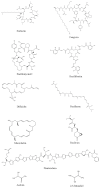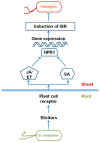Bacillus velezensis: A Valuable Member of Bioactive Molecules within Plant Microbiomes
- PMID: 30884857
- PMCID: PMC6470737
- DOI: 10.3390/molecules24061046
Bacillus velezensis: A Valuable Member of Bioactive Molecules within Plant Microbiomes
Abstract
Bacillus velezensis is an aerobic, gram-positive, endospore-forming bacterium that promotes plant growth. Numerous strains of this species have been reported to suppress the growth of microbial pathogens, including bacteria, fungi, and nematodes. Based on recent phylogenetic analysis, several Bacillus species have been reclassified as B. velezensis. However, this information has yet to be integrated into a well-organized resource. Genomic analysis has revealed that B. velezensis possesses strain-specific clusters of genes related to the biosynthesis of secondary metabolites, which play significant roles in both pathogen suppression and plant growth promotion. More specifically, B. velezensis exhibits a high genetic capacity for synthesizing cyclic lipopeptides (i.e., surfactin, bacillomycin-D, fengycin, and bacillibactin) and polyketides (i.e., macrolactin, bacillaene, and difficidin). Secondary metabolites produced by B. velezensis can also trigger induced systemic resistance in plants, a process by which plants defend themselves against recurrent attacks by virulent microorganisms. This is the first study to integrate previously published information about the Bacillus species, newly reclassified as B. velezensis, and their beneficial metabolites (i.e., siderophore, bacteriocins, and volatile organic compounds).
Keywords: Bacillus velezensis; bioactive compound; induced systemic resistance; volatile organic compound.
Conflict of interest statement
The authors declare no conflict of interest.
Figures




Similar articles
-
Comparative Genome Analysis Reveals Phylogenetic Identity of Bacillus velezensis HNA3 and Genomic Insights into Its Plant Growth Promotion and Biocontrol Effects.Microbiol Spectr. 2022 Feb 23;10(1):e0216921. doi: 10.1128/spectrum.02169-21. Epub 2022 Feb 2. Microbiol Spectr. 2022. PMID: 35107331 Free PMC article.
-
Whole-genome sequencing of Bacillus velezensis LS69, a strain with a broad inhibitory spectrum against pathogenic bacteria.J Biotechnol. 2017 May 10;249:20-24. doi: 10.1016/j.jbiotec.2017.03.018. Epub 2017 Mar 18. J Biotechnol. 2017. PMID: 28323017
-
Whole-genome sequencing of Bacillus subtilis XF-1 reveals mechanisms for biological control and multiple beneficial properties in plants.J Ind Microbiol Biotechnol. 2015 Jun;42(6):925-37. doi: 10.1007/s10295-015-1612-y. Epub 2015 Apr 10. J Ind Microbiol Biotechnol. 2015. PMID: 25860123
-
Biological control of plant pathogens by Bacillus species.J Biotechnol. 2018 Nov 10;285:44-55. doi: 10.1016/j.jbiotec.2018.07.044. Epub 2018 Aug 30. J Biotechnol. 2018. PMID: 30172784 Review.
-
Antimicrobial Activities of Lipopeptides and Polyketides of Bacillus velezensis for Agricultural Applications.Molecules. 2020 Oct 27;25(21):4973. doi: 10.3390/molecules25214973. Molecules. 2020. PMID: 33121115 Free PMC article. Review.
Cited by
-
Antimicrobial activities of Bacillus velezensis strains isolated from stingless bee products against methicillin-resistant Staphylococcus aureus.PLoS One. 2021 May 11;16(5):e0251514. doi: 10.1371/journal.pone.0251514. eCollection 2021. PLoS One. 2021. PMID: 33974665 Free PMC article.
-
Draft genome sequence of Bacillus velezensis endophytically isolated from roots of Polygala paniculata.Microbiol Resour Announc. 2024 Oct 10;13(10):e0082624. doi: 10.1128/mra.00826-24. Epub 2024 Sep 16. Microbiol Resour Announc. 2024. PMID: 39283091 Free PMC article.
-
Effect of dietary metallo-protease and Bacillus velezensis CE 100 supplementations on growth performance, footpad dermatitis and manure odor in broiler chickens.Anim Biosci. 2022 Oct;35(10):1628-1634. doi: 10.5713/ab.22.0033. Epub 2022 May 2. Anim Biosci. 2022. PMID: 35507846 Free PMC article.
-
Genetic, Epigenetic and Phenotypic Diversity of Four Bacillus velezensis Strains Used for Plant Protection or as Probiotics.Front Microbiol. 2019 Nov 15;10:2610. doi: 10.3389/fmicb.2019.02610. eCollection 2019. Front Microbiol. 2019. PMID: 31803155 Free PMC article.
-
A simplified synthetic community rescues Astragalus mongholicus from root rot disease by activating plant-induced systemic resistance.Microbiome. 2021 Nov 4;9(1):217. doi: 10.1186/s40168-021-01169-9. Microbiome. 2021. PMID: 34732249 Free PMC article.
References
-
- Hartmann A., Rothballer M., Schmid M. Lorenz Hiltner, a pioneer in rhizosphere microbial ecology and soil bacteriology research. Plant Soil. 2008;312:7–14. doi: 10.1007/s11104-007-9514-z. - DOI
Publication types
MeSH terms
Substances
LinkOut - more resources
Full Text Sources
Other Literature Sources

